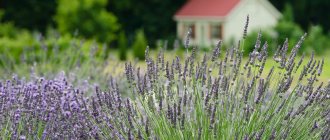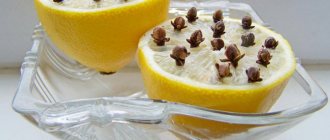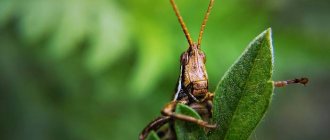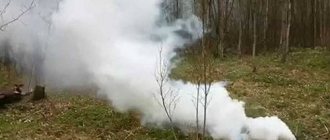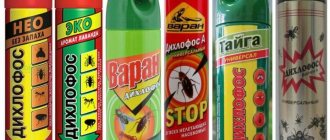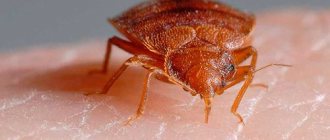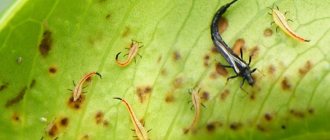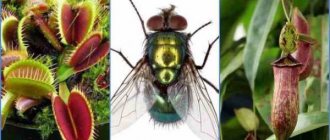Flowers that eat flies
Most insectivorous plants are perennial herbs, but there are exceptions in the form of shrubs.
In nature, this species has a non-standard appearance and bizarre reaction. The most popular insects that feed on certain living things are:
- Byblis gigantica;
- Sarracenia;
- Nepenthes;
- Genlisey;
- Pemphigus;
- Zhiryanka;
- Sundew;
- Venus flytrap.
Let's celebrate! The names are naturally complex, but the appearance of these plants may seem familiar to you. Below we will look at each of the insectivores in more detail.
Sundews
The largest genus of carnivores with almost 200 species. Sundews can be from 1 cm to a meter in length and are long-lived, with a lifespan of 50 years if properly cared for.
The sundew is a perennial flower with tentacles at the base. The tentacles are always long and thick, and also too sticky.
With these tentacles, the plant drives the victim into a trap and sucks out from it all the nutrients that were intended for active growth and development.
Sundew eats:
- Muh;
- Komarov;
- Moshek.
The only interesting fact is that the tentacles do not react to third-party hits in the form of:
- Garbage;
- Water;
- Sand,
Let's celebrate! Dried sundew flowers are available at pharmacies and are good for coughs and diarrhea. And in the North, this plant is used in the form of treating milk vessels, which remove all harmful substances that help milk sour.
Zhiryanka
A plant that has an active way of catching various insects, there are almost 90 species of plants.
The leaves of the butterwort have an acidic pink or green color that attracts insects. Growing requires a lot of light and heat, only in this case the growth functions will be met.
Therefore, it feels good in the heat; stones can be placed at the bottom of the pot to retain the necessary moisture. However, you should not oversaturate the body with water, as the root may rot. Water only with warm water 2 times a week, only under the leaves.
Note! You should not feed the plant with dead insects; it can provide food for itself, but it categorically denies and does not eat dead insects. Depending on care, life expectancy can be up to 20 years.
Venus flytrap or Dionaea
This plant was mistakenly called a mousetrap by botanists, and in Russian it acquired the beautiful name Venus flytrap.
It lives in the swamp, as there is high humidity there. The appearance is very interesting, the leaves of the flycatcher look like insect traps. The flycatcher is a passive food catcher.
As soon as a living creature lands on a leaf, the valves reflexively close, but as soon as the prey is completely digested, the valves open again in anticipation of the insect.
Dionaea is not easy to grow at home, and all this is due to the necessary watering and the level of acidity in the soil, but if the conditions are created correctly, the flower will delight the owner for 30 years. It is very useful to take the plant outside so that it can consume fresh air.
Sarracenia
Found on the coast of North America. In the swamp they form tall thickets, 70-90 cm long. Most of the species have a bright color, which attracts insects.
A characteristic feature is the leaves are shaped like a vessel with a hood. The leaves reach large sizes.
At home he feels comfortable with:
- Planting in special soil, which consists of soil and sand;
- Lack of feeding;
- When watering daily, the soil should not be dry;
- Sunlight, which lasts 8-10 hours a day;
Note! Sarracenias can live a long time with proper care. If a flower dries out or suffers from a disease, it should be transplanted into a new pot with different soil, observing watering and sunbathing.
Nepenthes
Nepenthes is a tropical insectivore. There are more than 100 species and are distributed in Austria, the Philippines, and Madagascar. It is sometimes called monkey's cup because some scientists have observed these animals drinking water from this flower.
It usually takes the form of a bush, but sometimes lovers of exotic plants can try care. The length of Nepenthes is up to 30 cm, provided the house is tall, but in nature it is almost one meter.
The lifespan is no more than 3 years, the specified period has a maximum limit, usually the life of a flower lasts only 1.5 years and this is with proper care and comfortable conditions.
Why do plants eat animals?
The image of a plant is associated with green leaves, in which, under the influence of photons of light, carbon dioxide and water form a glucose molecule - the simplest and most energy-rich organic compound.
This description of the photosynthesis process is actually too simplified.
So complex multi-stage reactions take place in a green leaf that the appearance of organic molecules from water and carbon dioxide seems like a miracle.
Predatory flowers are entire chemical laboratories
However, this miracle feeds a huge number of organisms from bacteria to elephants and, of course, humans. Why, then, should plants, which have created a whole laboratory for the production of their own food, become like animals that eat each other?
Another question logically arises: if a plant switched to an animal method of nutrition, then why don’t animals gain the ability to photosynthesis.
However, today photosynthetic animals eat only in the world of single-celled organisms. Among multicellular animals, there is not a single species that has switched at least partially to the process of photosynthesis. The sloth's green fur doesn't count - it doesn't photosynthesize. Algae just grows there - after all, a large animal prefers a sedentary lifestyle, and the air in the jungle is always humid.
It's all about lifestyle. Evolution is the antipode of revolution. Radical mutations usually lead to the death of the individual. A new species appears from a set of micromutations that improve the position of individuals in the battle for vital resources. Plants are immobile - this is their main evolutionary feature or trap, depending on which way you look at it. Animals can move, some do it very well. And this is also an advantage, a sign and an evolutionary cage from which they cannot escape. For more information about predatory flowers, watch this video:
An animal can migrate, move in search of food, and engage in fights for a place in the sun. For this reason, evolution works to ensure that animals acquire the ability to run, hide, cheat, steal, kill rivals, change the biotope, etc.
Plants do not have this opportunity. They are forced to realize themselves where the seed has sprouted.
For this reason, the selection of micromutations for compliance with the living conditions of the species has a slightly different direction. A plant that can realize itself only within the narrow confines of its biotope is forced to adapt only to the conditions of this biotope. However, there is competition almost everywhere, except in very extreme conditions. In environments where plants that eat animals live, there are also many competitors. And most importantly, there is little nitrogen there. This element is the basis for the formation of complex organic molecules, including proteins.
Carnivorous plants have found a convenient way to compete with other plants for nutrients
Evolution has given some species of plants that are stuck in nitrogen deficiency a way out—to consume it from the bodies of other organisms. This solution to the problem is not so original.
Parasitic and semi-parasite plants went in the same direction, as well as species that went underground in order to feed exclusively on dead organic matter.
One part of these strange products of evolution has lost the ability to photosynthesize, while the other manages to combine parasitism or predation with the production of its own organic matter. The last category includes all predators of plant origin.
Methods of propagation of the Venus flytrap
Dionea can be propagated in three ways:
- dividing the bush (bulb);
- leaf cuttings;
- from seed.
The bush is divided in the spring after hibernation, during the replanting of the flycatcher. The bush is removed, shaken off the soil and divided into bulbs. The separated onion should have roots. It is placed with the roots down in the prepared substrate and sprinkled, leaving only the sprout on top. The top of the former shoot is removed and sprinkled with coal. The soil should be moist; for the first time, you can cover the container with transparent material and place it in a brightly lit place, this will allow the seedling to take root faster. After the first leaves appear, care is carried out as for an adult plant.
Venus flytrap cuttings are taken from a healthy plant. To do this, a leaf is pinched off at the base of the roots, its trap is removed, and the cutting itself is placed in a greenhouse. The presence of white color at the bottom of the stem indicates the correct separation of the cutting. It is recommended to maintain very high humidity and good lighting, and periodically ventilate the planting to avoid rotting. If all conditions are met, the leaf will die, giving life to a small seedling. After two to three months, it can be transplanted and cared for as usual.
Growing a Venus flytrap from seed is the most time-consuming and difficult approach.
The seeds are grown in a special greenhouse, it can be just a box covered with transparent polyethylene or glass. The purchased seeds must be no older than a year, otherwise there is a possibility that they will not germinate. First they indulge in cold stratification. One way is to place them in soil, damp gauze or a napkin, wrap them tightly in film and put them in the refrigerator for a month and a half. Before this, it is necessary to treat the seeds with a solution of a fungicide, for example, topaz in the proportions of two drops per glass of distilled water.
Seeds obtained from a flower box are best sown within 2-3 days. When healthy and ripe, they should have a black, smooth, hard surface, shaped like a droplet. The seed capsule must be completely dry, usually it contains about 30 seeds about 2 mm in size.
The optimal period for sowing will be the end of September or the beginning of October.
Seeds are poured into the moist soil prepared for the flytrap, and it is allowed to sprinkle them a little with the substrate. Next, the pot is covered and placed in a warm (25-27 °C), humid (40-60%), brightly lit place. The main conditions are lighting in the sun or under a fluorescent lamp for at least 16 hours every day, and bottom watering of the soil. Shoots are expected within a period of one to three months. As soon as the leaves appear, the seedlings will need to be ventilated periodically by opening the greenhouse lid
During the first three months, the mature plants are planted in separate containers, being careful with the roots. Further care is carried out by fulfilling the conditions described above for the Venus flytrap. A full-fledged, mature plant grown from seed should be expected no earlier than after 5 years
A full-fledged, mature plant grown from seed should be expected no earlier than after 5 years.
After growing by any of the methods, the plant will grow for about 5 months, and then it will begin to prepare for winter and lose its activity. To stop hibernation, the flycatcher can be transplanted into new soil, after which it will still grow, but wintering must be carried out.
Reproduction methods
Eschynanthus can be propagated in two ways - cuttings and growing from seeds.
Growing from seeds
The process is quite complex, so only experienced flower growers do it. This also requires a lot of patience, because many seedlings do not survive and die early.
Seeds are planted in moistened soil and a greenhouse environment is created for them using glass or film. Every day the shelter must be raised briefly to get rid of condensation. Water the seeds through the bowl of the tray. Then small sprouts with the appearance of a pair of leaves are transplanted into separate pots; the first portion of fertilizer can be introduced after 10 days. With proper care, they will bloom next year.
By cuttings
At 4-5 years the plant loses its attractiveness, so a new young specimen needs to be grown vegetatively. To do this, you can cut the cuttings in spring or summer or use shoots after seasonal pruning of the bush.
It is desirable that it has several leaves and 1-2 nodes; the length can be no more than 12 cm. The cutting should be placed in moistened peat with sand, removing the lower plates. Place a thick layer of drainage on the bottom of the container, and cover the top with a transparent film or plastic bag. Every day they need to be removed briefly for ventilation. The air temperature should be between 22-25 degrees. The roots will appear within 2 weeks, after which you can transplant them into a pot.
Features of morphology and evolutionary adaptations
The life form of most insectivorous plants is herbaceous perennials, only a few species of which are shrubs, for example, Australian shrubs of the genus Byblis. And representatives of the genus Nepenthes are tropical vines. The root system is poorly developed, and in aquatic representatives of predator plants, it is completely reduced.
Note: if favorable conditions are created in an aquarium for the aquatic predator bladderwort, it will develop a horse system and partially or completely abandon the heterotrophic type of nutrition (that is, it will lose the ability to hunt).
Trapping devices for hunting - traps, jugs, hairs, “claws” - modified leaves. In some species (nepenthes, sarracenia), the trapping leaves have completely or partially lost their green color, acquiring a bright color. In Genlisea, the trap leaves can be located underground, plunging, sometimes to a depth of 15-20 cm. In color and shape, the twisted trap leaves resemble a rhizome or bulb. These same leaves perform the function of roots: they hold the genlisea on the surface of the substrate and provide the plant with minerals. Green trap leaves, in addition to their main function, also photosynthesize, providing the plant with autotrophic nutrition.
During evolution, plants have developed various methods of attracting prey:
- bright color;
- smell (sometimes it is not pleasant to humans, but attracts insects that feed on carrion);
- sweet juice (containing glucose).
Carnivorous plants can be divided into active and passive predators. In the first, the traps are closed (Venus flytrap, Aldrovanda, bladderwort, Genlisea). Secondly, the traps are static - nepenthes, butterwort, sarracenia, darlingtonia.
Digestion of protein foods occurs thanks to organic acids and digestive enzymes (pepsin), which are produced by plant cells. After external breakdown of proteins, amino acids and mineral elements are absorbed by the plant.
Note: sensory hairs on plant leaves are so developed that they can distinguish living from non-living. Sundews and Venus flytraps do not react if a drop of water or a piece of bark falls on the leaves of the trap.
All carnivorous plants are classified as angiosperms, and accordingly, can bloom. Most of these plants have small, white or light pink flowers. But there are also representatives with bright colors: genlisea (blue and purple), biblis (purple, lilac, blue, white).
https://youtube.com/watch?v=_6t1bgPes9A%3Fenablejsapi%3D1%26autoplay%3D0%26cc_load_policy%3D0%26iv_load_policy%3D1%26loop%3D0%26modestbranding%3D0%26rel%3D1%26showinfo%3D1%26fs%3D1% 26playsinline%3D0%26autohide%3D2%26theme%3Ddark%26color%3Dred%26controls%3D2%26
Species diversity and occurrence
Most insectivorous plants are perennial herbs, but there are several species that are subshrubs and even shrubs. They are classified as species that have a narrow adaptation to environmental conditions. Typically, such species are distinguished by their unusual and bizarre adaptive reactions.
Byblis giant
- The giant in the world of predators is the giant biblis. In the world of small predators, it is a giant, but among ordinary shrubs, Byblis is not very tall - no more than 50 centimeters. This predator grows in Australia. Since the Byblis is truly a giant among its fellows, its prey is corresponding. It catches not only insects and shellfish, but also frogs and lizards.
- Nepenthes are woody tropical vines. It is not entirely correct to classify them as predators. However, these plants are so unusually adapted to obtain nitrogen not from the soil that it is worth mentioning such an invention of evolution. Some species of Nepenthes use nectar not to attract insects for the purpose of pollination, but so that small mammals can use the nectar. However, the main reward for a flower is not pollination, but the excrement that some mouse or monkey can leave. The excrement contains a lot of nitrogen, which is absorbed by the above-ground part of the plant.
- Dew leaf is a plant large enough for a group of green predators. This is a subshrub reaching a height of 30 centimeters. Grows in the Pyrenees and North Africa. He catches flies like sticky paper, which is why the local peasants love him.
Mosquitoes stick to dew leaf like sticky paper
Sticky fat woman
Almost a complete analogue of duct tape, which just a couple of decades ago hung from the ceiling of almost every diner in the summer. True, Pinguicula, or butterwort, is much more beautiful than those dark brown spirals of the past. The bright green or pink leaves are covered on the outside with two types of cells. The pedicel glands, located closer to the stem, produce mucus containing glue that attracts with its smell, and at the same time reliably fixes insects. This is the same Velcro. The second type of cells are the so-called sessile glands. They belong directly to the digestive system and produce protease, esterase and amylase, that is, enzymes that decompose living organisms into components useful for the plant.
Some species of butterwort hide under a dense rosette for the winter, only to bloom again in the spring and continue merciless hunting, spreading carnivorous sticky leaves.
How to grow a Venus flytrap at home
Interestingly, this predatory flower grows well both in the wild and in ornamental gardening. Moreover, you can grow a Venus flytrap at home, however, careful care is required, especially monitoring the level of humidity in the room in the winter, when heaters dry the air.
It cannot be said that the Venus flytrap is a whimsical plant for growing at home. Since its natural habitat is the coast of the Atlantic Ocean, the plant is accustomed to seasonal temperature changes. Under natural conditions, even with the first frosts and snowfall, the Venus flytrap does not die, but the flower cannot withstand severe and prolonged frosts. In winter, at home, the lower rosette of leaves remains from the plant, that is, the ground part on which the plant feeds dies.
Until spring, the V. flycatcher is in a dormant state, but with the first warmth and sunlight, the plant begins to lead its predatory lifestyle.
The underground short stem - the bulb begins to actively fill with juice, a rosette of seven leaves appears, each of which can reach up to 10 centimeters. The leaves sprout alternately, one above the other, according to the “storey” principle. Along with the first leaves, stems appear on which quite beautiful white flowers bloom. And only after the plant fades, the leaves transform into a trap. This is the basic information from the field of botany that exotic flower growers need to know.
It is fair to say that now this exotic plant is increasingly being grown at home. The flower can grow both in an apartment on the windowsill and in the garden.
Caring for a Venus flytrap is quite simple, but there are a few things to keep in mind.
In order for a flower to feel comfortable at home, you need to follow one of the main rules of care, namely, imitation of natural conditions:
- sufficient humidity - there should always be water in the pan (except for the rest period);
- sandy-peaty soil - soil from the garden is not suitable for growing this plant due to its acidity;
- good level of light, but not on the south side, or light shading.
Although the plant is light-loving, it does not tolerate stagnant hot air, so regular ventilation is necessary. In general, if you want your flycatcher to feel comfortable in your home, care is simple - keep it on the sunny side, open the windows more often and use air conditioners whenever possible to humidify the air. In winter, there is no need to place the pot next to the heaters.
For proper care, you should keep the Venus flytrap in a pot on a tray with a supply of clean or rain water - after all, the plant loves wetlands in nature.
What types of carnivorous plants are there?
The term carnivorous plant refers to representatives of the flora that have adapted to catching and digesting insects. With them they compensate for the lack of microelements and proteins. There are more than 600 species of biological insectivores in the world. They catch flies in several ways:
- Active method. Moving plant organs that are capable of capturing insects are used.
- Passive method. After landing, the potential victim is held in place by sticky or slimy surface elements.
The types of traps for specific carnivorous biorepresentatives also differ:
- closing trap-shaped leaves;
- jug-like traps that close after an insect enters;
- sticky and viscous external surfaces;
- suction traps.
Types of insectivorous flowers
Biological scientists have counted about 630 species of carnivorous plants from 19 families.
The most famous flowers that catch and eat flies:
- Venus flytrap;
- butterwort;
- sundew;
- slipway;
- genliseya;
- sarracenia;
Video description of predator plants:
The Venus flytrap, or Dionaea, is the most recognizable insect-eating flower. It is a favorite on the windowsill of many gardeners. This flower is native to North America. Its main habitat is swamps, but it can easily adapt to indoor conditions. Flycatcher leaves have toothed edges. As soon as the insect lands in the “mouth” of the flower, its blades immediately slam shut, like the mouth of a predator. The digestion process takes place hidden within 10 days. The leaf then opens up, sheds its empty shell and awaits its next prey.
Butterfly is considered one of the most beautiful plants that eats flies. It got its name due to the mucus covering the leaves. The surface acquires a shine, as if it has been greased. Butterwort emits a sweet aroma that attracts insects. The leaves completely cover the digestive glands that digest prey.
Despite its predatory nature, Zhiryanka is one of the most beautiful plants
The most common flower that catches flies is the sundew. Grows in mountains, swamps and sandstones. The leaves have long hairs that secrete a sweet, aromatic liquid similar to dew. When a fly touches the viscous syrup, the flower leaf curls up and is digested by the insect. A large sundew can even catch a dragonfly. English sundew and round-leaved sundew are common in Russia.
Stapelia is another houseplant that eats flies. It is often confused with a cactus, with which it has nothing in common. Stapelia flowers emit the smell of rotten meat, which attracts flies. They lay eggs in flowers. But the flower only lives for a day, which means the larvae die along with it, without having time to hatch.
The Genlisea flower looks very cute and tender. But this is only at first glance. It has hollow tubes containing a fragrant and sticky liquid that attracts insects. Having climbed into the tube, the insect cannot get back out and dies on the spot. The flower grows in Central and South America, as well as in Africa and Madagascar.
Genlisea looks like a gentle and safe plant, but this is deceiving
Sarracenia is another flower that eats flies. Its name is unusual. This funnel-shaped plant came from North America and has become well established in Russia as a house fly-eating potted flower. The sarracenia funnel is filled with sweet nectar, and its walls are very slippery.
Plant range
Despite their exotic nature, insectivorous plants are found throughout the Earth. Most often these are swamps and areas with high humidity. Many species are restricted to South and North Carolina (for example, the Venus flytrap), while others are native only to Australia. In Russia, carnivorous plants are represented by 13 species, among which the most famous are sundew, butterwort and bladderwort. They grow in the European part, the Caucasus and the Far East. Many species can be found not only in swampy areas, but also along the banks of rivers, lakes, on trees and stumps.
Variety of traps
All carnivorous plants, according to the method of catching, are divided into those who catch actively and passively. Active catchers have special baits that move and thereby attract the attention of insects. This group includes sundew and flycatcher.
Passive catchers form traps in the form of sticky and mucous secretions on the leaves, jugs, and bubbles.
It is difficult to understand whose strategy is better, but since these adaptations exist, it means it is beneficial for this species. The flycatcher and sundew spend energy moving, but they also catch more. Passive plants wait patiently, like a spider in its web, for someone to crawl towards them. But they don’t have to waste any extra energy—catch an insect and wait quietly again.
Bladderwort catching a fish fry
All the diversity of carnivorous plant species does not use many types of traps. This is due to the fact that it is mainly the leaves that evolve into the trap. So nature had no reason to create too many traps. There are five main types of traps:
- leaves rolled into a jug;
- traps made of two leaves;
- Velcro on leaf blades;
- traps with the effect of being sucked into liquid;
- something like a crab claw.
A distinctive feature of these devices is the complete absence of any connection between the type of trap and the taxonomic affiliation of the species.
Darlingtonia californica
Darlingtonia leaves are bulbous in shape and form a cavity with an opening underneath a balloon-like structure and two sharp leaves that hang down like fangs.
Unlike many carnivorous plants, it does not use trapping leaves to trap, but instead uses a crab claw type trap. Once the insect is inside, they are confused by the specks of light that pass through the plant. They land in thousands of dense, fine hairs that grow inward. Insects can follow the hairs deep into the digestive organs, but cannot return back.
Beware, carnivorous flower! Plants that bite (14 photos)
Carnivorous plants are quite widespread throughout the world. In nature, there are 450 species of similar plants, which are grouped into six families. The basis of their diet is insects, which is why carnivorous plants are often also called insectivores.
Source:
Source:
Carnivorous plants are a miracle of nature. They have amazingly adapted to life in places characterized by a lack of nutrients in the soil. These plants have become predators! The need for survival requires them to be able to catch live prey. Carnivorous plants obtain food in five ways. Some of them use trapping leaves that have the shape of a jug, others use sticky traps, the next use traps like rachen, the fourth use suction traps, and the fifth use slamming leaves.
Carnivorous plants have “developed” many ways to lure insects. For example, in some carnivorous plants, the edges of the trapping leaves are bright red, while in others, the inner walls of the leaves secrete a sugary substance, which attracts insects.
Venus flytrap
Source:
The most famous of the carnivorous plants is Dionaea muscipula, but its Russian name is Venus flytrap. According to one version, this plant predator was named after the Roman goddess because its trap leaves are shaped like a female genital organ. The trap itself is located on a short stem and looks like an open mollusk shell. Along the edges of the valves there is one row of teeth, comparable to long eyelashes. However, all this is just an entourage; the real weapons are the glands and trigger hairs. The glands are located along the inner side of the eyelash teeth and secrete a sweet-smelling nectar, which is so difficult for insects to pass by. When the victim crawls inside the trap, triggers come into play - they react to touch. The trap does not close immediately; only a few successive touches to the triggers (and there are three of them on each leaf) can close the trap. Dionaea, having received an insect in its trap, begins the digestion process. The same glands that produced nectar begin to abundantly secrete digestive juice, in which the insect drowns. Typically, digestion takes several days, after which the valves open again, revealing only the chitinous shell of the victim to the world.
Sundew
Source:
Round-leaved sundew (Drosera rotundifolia) is practically the only carnivorous plant growing in the territory of the former Soviet Union. It is found mainly in the northern and central regions of our country. The photo shows that it owes its name to small droplets of sticky liquid that are found on the hairs covering the leaves of this plant. These droplets sparkle in the sun and look very much like dew. They contain the digestive enzyme that allows the sundew to digest insects, and thus obtain the necessary nutrition even on poor peat soils. It is very interesting to watch how the sundew catches insects. Unlike the Venus flytrap, the sundew does not slam its trap. And the point here again is in the droplets covering the leaves. They are sticky enough to hold back an insect that has the temerity to be tempted by the sweet aroma of this plant. Once the insect has stuck, the leaf begins to slowly curl up, surrounding its victim with more and more clear, sticky liquid. After the leaf has completely rolled up, the digestion process begins, which usually takes several days. After this process is completed, the leaf unfolds and is again covered with droplets.
Nepenthes
Source:
The spectacular and original pitcher plant belongs to the genus Nepenthes, which includes several dozen species of plants of the Nepenthaceae family. The unusual shape of this flower immediately attracts attention. Even just once you see a photo of a Nepenthes, you can fall in love with it completely and irrevocably. But its main feature is that Nepenthes is a predator flower. Its attractive, colorful pitchers contain liquid that allows the flower to be digested and used as food for insects.
Sarracenia
Source:
Sarracenia, or North American carnivorous plant, is a genus of carnivorous plants that are found in areas of the east coast of North America, Texas, the Great Lakes, and southeastern Canada, but most are found only in the southeastern states. This plant uses water lily-shaped trapping leaves as a trap. The plant's leaves have become a funnel with a hood-like structure that grows over the hole, preventing rainwater from entering, which could dilute the digestive juices. Insects are attracted to the color, smell and nectar-like secretions at the edge of the water lily. The slippery surface and narcotic substance lining the nectar cause insects to fall inside, where they die and are digested by protease and other enzymes.
Darlingtonia
Source:
Darlingtonia californica is the only member of the Darlingtonia genus that grows in northern California and Oregon. It grows in swamps and springs with cold running water and is considered a rare plant. Darlingtonia leaves are bulbous in shape and form a cavity with an opening underneath a balloon-like structure and two sharp leaves that hang down like fangs. Unlike many carnivorous plants, it does not use trapping leaves to trap, but instead uses a crab claw type trap. Once the insect is inside, they are confused by the specks of light that pass through the plant. They land in thousands of dense, fine hairs that grow inward. Insects can follow the hairs deep into the digestive organs, but cannot return back.
Genlisey
Source:
Composed of 21 species, Genlisea typically grows in moist terrestrial and semi-aquatic environments and is distributed in Africa and Central and South America. Genlisea are small herbs with yellow flowers that use a crab claw type trap. These traps are easy to get into, but impossible to get out of because of the small hairs that grow towards the entrance or, in this case, forward in a spiral. These plants have two different types of leaves: photosynthetic leaves above ground and specialized underground leaves that lure, trap and digest small organisms such as protozoa. The underground leaves also serve as roots, such as water absorption and anchorage, since the plant itself does not have any. These underground leaves form hollow tubes underground that look like a spiral. Small microbes are drawn into these tubes by the flow of water, but cannot escape from them. By the time they reach the exit, they will already be digested.
Pemphigus
Source:
Bladderwort (Utricularia) is a genus of carnivorous plants consisting of 220 species. They are found in fresh water or moist soil as terrestrial or aquatic species on all continents except Antarctica. These are the only carnivorous plants that use a bubble trap. Most species have very small traps in which they can catch very small prey such as protozoans. Traps range from 0.2 mm to 1.2 cm, and larger traps catch larger prey such as water fleas or tadpoles. Bubbles are under negative pressure relative to their surroundings. The trap's opening opens, sucks in the insect and surrounding water, closes the valve, and all this happens in thousandths of seconds.
Zhiryanka
Source:
Butterwort (Pinguicula) belongs to a group of carnivorous plants that use sticky, glandular leaves to lure and digest insects. Nutrients from insects supplement mineral-poor soil. There are approximately 80 species of these plants in North and South America, Europe and Asia. Butterwort leaves are succulent and usually bright green or pink in color. There are two special types of cells found on the upper side of leaves. One is known as the pedicel gland and consists of secretory cells located at the top of a single stem cell. These cells produce a mucous secretion that forms visible droplets on the surface of the leaves and acts like Velcro. Other cells are called sessile glands, and they are found on the surface of the leaf, producing enzymes such as amylase, protease and esterase, which aid in the digestive process. While many butterwort species are carnivorous all year, many types form a dense winter rosette that is not carnivorous. When summer comes, it blooms and produces new carnivorous leaves.
Byblis
Source:
Byblis, or rainbow plant, is a small species of carnivorous plant native to Australia. The rainbow plant gets its name from the attractive slime that coats its leaves in the sun. Although these plants are similar to sundews, they are in no way related to the latter and are distinguished by zygomorphic flowers with five curved stamens. Its leaves have a round cross-section, and most often they are elongated and conical at the end. The surface of the leaves is completely covered with glandular hairs, which secrete a sticky mucous substance that serves as a trap for small insects that land on the leaves or tentacles of the plant.
Aldrovanda vesiculata
Source:
Aldrovanda Vesiculosa is a magnificent rootless, carnivorous aquatic plant. It typically feeds on small aquatic vertebrates using a snare trap. The plant consists mainly of free-floating stems that reach 6-11 cm in length. Trap leaves, 2-3 mm in size, grow in 5-9 curls in the center of the stem. The traps are attached to the petioles, which contain air that allows the plant to float. It is a fast growing plant and can reach 4-9mm per day and in some cases produce a new whorl every day. While the plant grows at one end, the other end gradually dies. The plant trap consists of two lobes that slam shut like a trap. The trap's openings point outward and are covered with fine hairs that allow the trap to close around any prey that comes close enough. The trap slams shut in tens of milliseconds, one of the fastest examples of movement in the animal kingdom.
Cephalotus
Source:
Cephalotus is the one and only predator from distant Australia. Despite their tiny size (adult plants usually reach only 7-10 cm), cephalotuses are incredibly attractive and interesting. The plant copes well with the role of a hunter, and certain tricks help it in this. Slippery edges of the jugs, sharp spines-growths that prevent insects from getting out of the trap, and special cells, devoid of pigment on the lid of the jug, which transmit light and create a deceptive impression of “open sky”. And of course, the deadly digestive fluid at the bottom of the trap. Such an insidious and cunning little cephalotus. However, from the outside he seems defenseless and requires care and attention. And this is also his little trick.
Heliamphora
Source:
Heliamphora is a predatory beauty native to South America. Its name comes from the places in which it lives, “jar of swamps” - this is how “Heliamphora” is translated. Indeed, most of all the plant resembles bright pitchers that grew in inconspicuous gray swamps. The heliamphora's hunting method is simple and straightforward. The predator attracts insects with nectar, which is produced in the so-called nectar spoon located on the hood of the jug, and when the insect lands on the jug, it literally rolls down the smooth slippery walls inside, where digestion occurs. As they say, everything ingenious is simple.
This is what you should think about before you start a flower at home.
Source:
Some interesting facts
Among these insects there are many species with unusual feeding preferences. Let's look at what flies eat in natural conditions:
- There is a special type, cheese flies, that can breed and feed inside the cheese wheel. They are called pyophilides.
- The striped yellow-and-black syrphid, or hoverfly, a wasp-like dipteran, eats flower nectar.
- The larvae of hover flies are distinguished by an enviable appetite: during their development to an adult, each of them eats more than 2 thousand aphids.
- The dangerous Tsetse fly prefers the blood of wild animals, cattle, and people as food. The bite of this African resident can cause incurable diseases of the nervous system and immunity.
Among the flies there are also real predators, for example, ktyri, owners of a sharp poisonous sting. Their food includes mosquitoes, midges, even bees and flies. Interestingly, some types of flies are cultivated by fishing fans. Thus, the blue spring fly is specially bred on bird droppings, pig manure, its food is rotting organic remains, and the insects are also fed with sugar and dry milk.
Predatory plants in the house
The choice should be made in favor of Sundew or Flycatcher. After you buy an indoor flower that catches flies, it needs some time to adapt to a new place. From time to time you will have to catch several live insects for him, because they are the ones who activate the digestive process. You cannot feed it with large bugs; they should be half the size of the trap itself. Three flies a day are enough, no more.
Plant propagation
Insectivorous plants are propagated by dividing the bush or by cuttings; the flowers themselves prefer pollination. In nature, insects help them, but at home they have to get used to manually transferring pollen from the stamens to the pistil. Many species bloom at the end of spring.
In nature, these flowers reproduce by pollination, but cuttings are also possible at home.
Winter care
In winter, carnivorous plants stop growing and go dormant. During this time, the flower gains strength for further growth and flowering. During this period, you need to continue to care for the plant, removing dried leaves and watering.
Home conditions
The following carnivorous flowers can be kept indoors:
- tropical butterwort;
- sundew;
- Venus flytrap;
- sarracenia.
It is better to keep a pot with a carnivorous flower in a well-lit place. This could be a windowsill or artificial lighting (in winter, with a lack of sunlight). Such flowers love moist soil, so you need to avoid drought and water them in time with melted, slightly acidic or neutral water. Salts in tap water can kill the plant. Carnivorous flowers need moderate temperatures: +15...+30°C in summer and +10...+14°C in winter.
Diseases and diagnosis
In order to identify diseases and pests in time, you need to pay attention to the following signs.
- Web. Indicates the appearance of spider mites. The cause may be a poorly ventilated room with dry air. Can be cured with insecticides.
- Pale spots on leaves. This is a manifestation of thrips - small insects that feed on plant juices. They are activated at low air humidity. It is treated with drugs from specialized stores.
- White plaque. It is a sign of powdery mildew, which appears at very high air humidity. At the initial stage, you can spray with a solution of potassium permanganate. In case of severe damage, it is necessary to remove all infected leaves and spray the crown with special medicines against this disease.
If the specimen lacks something in its diet or conditions of detention, it will also signal this.
- The leaves are turning yellow. A sign of moisture deficiency, as well as lack or excess of light.
- Leaves and stems darken. This means that waterlogging occurred and sudden temperature changes were allowed.
- The leaves are falling. This happens when the air temperature is too low, drafts and irregular watering.
- Gray rot, similar to mold. Appears if the pot is in a cold and damp place.
- Brown spots. Their appearance indicates that when watering they used water that was too cold (less than 20 degrees).
- The leaves are curling. This happens if the air in the room is too dry or there is not enough humidification during the heating season.
- House plants
8 diseases of indoor plants that are easily confused with each other
Fly protection for pets
In hot weather, chained dogs suffer more than others from flies. Hungry insects literally gnaw off the tips of the poor creatures' ears; pathogenic microflora immediately settles on the resulting wounds and they begin to rot. To prevent attacks on pets and other living creatures, special preparations that repel flies are used, which, like flea drops, are applied along the spine and on the back of the animal’s head.
To protect cats and dogs in the summer, there are special repellent substances that can be applied to the withers or included in collars. These are, for example, such products as Bayofly, Flybyte, as well as the recognized leader in the fight against flies in yards with domestic and farm animals - Agita. It contains the fly pheromone Z-9 tricosene and thiometaxam, lactose and sugar. The product is dissolved in warm water, mixed well and sprayed on the surface or applied to window openings and strips of paper. It attracts dipterans, which soon die after contact with the toxic substance. The product is used to treat only those surfaces that never come into contact with food and animals.
Plants are antipodes to predators
In addition to plants that eat insects, there are also plants that repel flies.
This property is associated with a large amount of phytoncides that plants secrete.
However, not all phytoncides are directed specifically against insects; some substances are used to combat competing species. Plants that chemically fight insects are called repellents.
Plants that repel insects
These include:
- tansy;
- Walnut;
- all types of geraniums;
- sagebrush;
- lavender;
- various types of mint;
- nasturtium;
- thyme;
- coriander;
- horseradish;
- marigold;
- garlic;
- chives;
- mustard;
- fennel.
From the whole variety of cultivated and wild plant species, it is very simple to select those that are able to repel not only flies, but also other insects. They are usually not affected by common pests of our gardens and vegetable gardens - whiteflies, thrips, aphids and other lovers of juice and green mass. For more information about such plants, watch this video:
This is especially noticeable on indoor plants. If you plant a geranium and a tangerine, rose or chrysanthemum in contaminated soil, then soon the last three species will be entwined with mite webs and strewn with thrips and aphids. At the same time, it will not be possible to find any boogers on the geranium. It will repel all insects, including clothes moths.
Prevention of flies
These frightening factors are a good reason to fight against unpleasant insects.
But you should understand: in order not to start a war with flies, lovers of dirt, certain preventive measures are necessary:
- maintaining cleanliness in the house at the proper level: frequent wet cleaning, timely disposal of garbage;
- lack of any food on the table;
- regular cleaning of the livestock pen (if any), watering the manure with karphos solution;
- mosquito nets on windows;
- pots of geraniums on the windowsills of the house;
- plants with a pungent odor planted on the site: tansy, lavender, wormwood, elderberry and bird cherry bushes.
Compliance with this series of rules will not only help you get rid of annoying insects, but will not force you to face such a problem as flies indoors.
Sources
- https://nzs-rst.ru/muhi/trava-otpugivayushchaya-muh.html
- https://notklop.ru/muhi/2-fakty/25-kakoj-zapah-otpugivaet-muh/
- https://kursi-floristiki.ru/sredstva/kakie-rasteniya-otpugivayut-muh.html
- https://KatalogPoleznogo.ru/dom/30-sposobov-vyivesti-muh-iz-kvartiryi-doma-dachi.html
- https://WikiParazit.ru/babochki-i-moshki/rasteniya-i-narodnye-sredstva-kotorye-otpugivayut-muh.html
- https://stroy-podskazka.ru/muha/zapahi-ne-lyubyat/
- https://antinasekom.ru/kak-borotsya-s-muhami.html
- https://nasekomye-vrediteli.ru/ot-muh-trava.html
- https://hloptarakan.ru/muhi/chto-otpugivaet-muh.html
Types of home remedies for flies
To combat flies inside a house or apartment, both folk remedies and special factory-made devices can be used.
Fly repellent
Folk remedies
There are many home remedies that repel or kill annoying dipterans. Knowing how to fight flies with folk remedies, it is not necessary to purchase industrial devices and compounds in stores. Among the folk remedies, the following are most often used:
- Plants. For example, leaves of fern and black elderberry, pelargonium, tomato tops, tansy grass, hanging in the kitchen and dining room can rid these rooms of flies quickly and safely.
- Poisonous traps with black pepper or chlorophos. Pepper is the same poison for dipterans as the known organophosphorus compound. The poisonous powder is mixed with sugar and placed on windows, refrigerators and furniture. Black pepper can also be sprinkled around the areas where they accumulate.
- Turpentine, castor oil, melting wax are substances that successfully repel flies from your home. True, people don’t like their smell either, so they are used only in rooms where people stay for a short time.
- Essential oils. The most effective oils are citronella, clove, eucalyptus, peppermint and lavender.
- Fly traps from a liter jar. In which bait (for example, sweet water) is poured and a cardboard cone is installed.
Store products
The following devices and devices are most often offered to combat flies:
- Ultrasonic fly repeller. A modern electronic device that can repel insects using high-frequency sound.
- Mosquito net. Framed or magnetic, they mechanically prevent them from entering your home from the street.
- Fly plates. Used similarly to mosquito repellent plates. Evaporating from the surface of the plate, the systemic insecticide kills adult insects.
- Sticky fly tape. An old remedy that has not lost its effectiveness. A mixture of a viscous substance and bait is applied to a thick paper tape. Having sat down on the tape, the fly cannot free itself with it and soon dies. Fly tape has one significant drawback - it is not very aesthetically pleasing and does not decorate the interior with its appearance.
- Liquid for fumigator against flies. It is used in the same way as the anti-mosquito composition - it is simply poured into the device, after which it is connected to the network.
- Insecticide sprays. An excellent choice for those who decide how to poison flies that appear in large numbers in the house. The spray is a highly effective means of killing adults. Some of them can be applied to the mosquito net and around the perimeter of the opening, since they have a long-lasting repellent effect.
Medical advice from Elena Malysheva on getting rid of flies on video:
